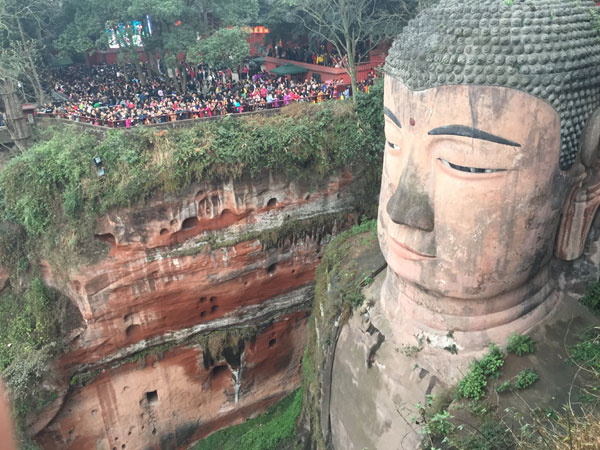 |
|
Jimmy Nesbitt visited the Leshan Giant Buddha in Southwest China's Sichuan province, which is one of the world's largest Buddha statues. [Photo provided to chinadaily.com.cn] |
Every year, I tell myself I'll travel outside the country for the Spring Festival holiday to avoid the crowds. But because airline tickets are always so expensive during the holiday, I usually end up staying in China.
This year, I visited Chengdu in Sichuan province, a place I'd always wanted to see mostly so I could eat my way through the province's well-known cuisine. The local restaurants didn't disappoint. I ate as much spicy food as I could, until my stomach through up a white flag after a fiery-hot meal of Sichuan hotpot.
I wanted to travel to the Sichuan-Tibet border to get a closer look at the mountainous countryside, but the trip would have taken half a day by bus and eaten up too much of my short holiday.
I settled on nearby Leshan, home of the largest stone Buddha statue in the world. It has been listed as a UNESCO World Heritage Site since 1996. The 71-meter-high Buddha was carved into the side of a mountain, and visitors can hike down a narrow, winding staircase to get a look at the Buddha from its base.
When I arrived in mid-afternoon, the line for the staircase was at least 1,000-people deep. Security officers were only letting small groups of people through at a time, to keep the staircase from becoming too crowded. Rather than wait in line for several hours and risk missing my bus back to Chengdu, I took a few pictures of the Buddha from an overlook and moved on to a nearby temple.
I enjoyed strolling around the temple's vast grounds, but the huge crowds waiting to see the giant Buddha made the whole experience anything but tranquil.
The other main attraction I visited was the Chengdu Research Base of Giant Panda Breeding. The research base, which was established in 1987 to further the Chengdu Zoo's conservation efforts, is huge, very green, and provides a nice escape from the concrete jungle of downtown Chengdu.
Signs outside the panda enclosures tell you the Chinese and English names of the animals and describe their personalities: playful, moody, friendly, etc. Many of the pandas were already asleep when I got there, but a few were up and chomping on bamboo stalks, much to the delight of onlookers.
The panda is the national animal of China, and the city of Chengdu does a good job of promoting it. All of the city's cabs have images of pandas on their hoods, and once the driver puts the flag down, an electronic message welcomes you to "the home of the Giant Panda."
Aside from the countless spicy dishes I sampled, visiting the Giant Panda breeding base was my favorite part of the trip. I'd like to visit Sichuan province and the Giant Buddha again, but just not for Chinese New Year.
|
|
|
|
|
|
|
|
